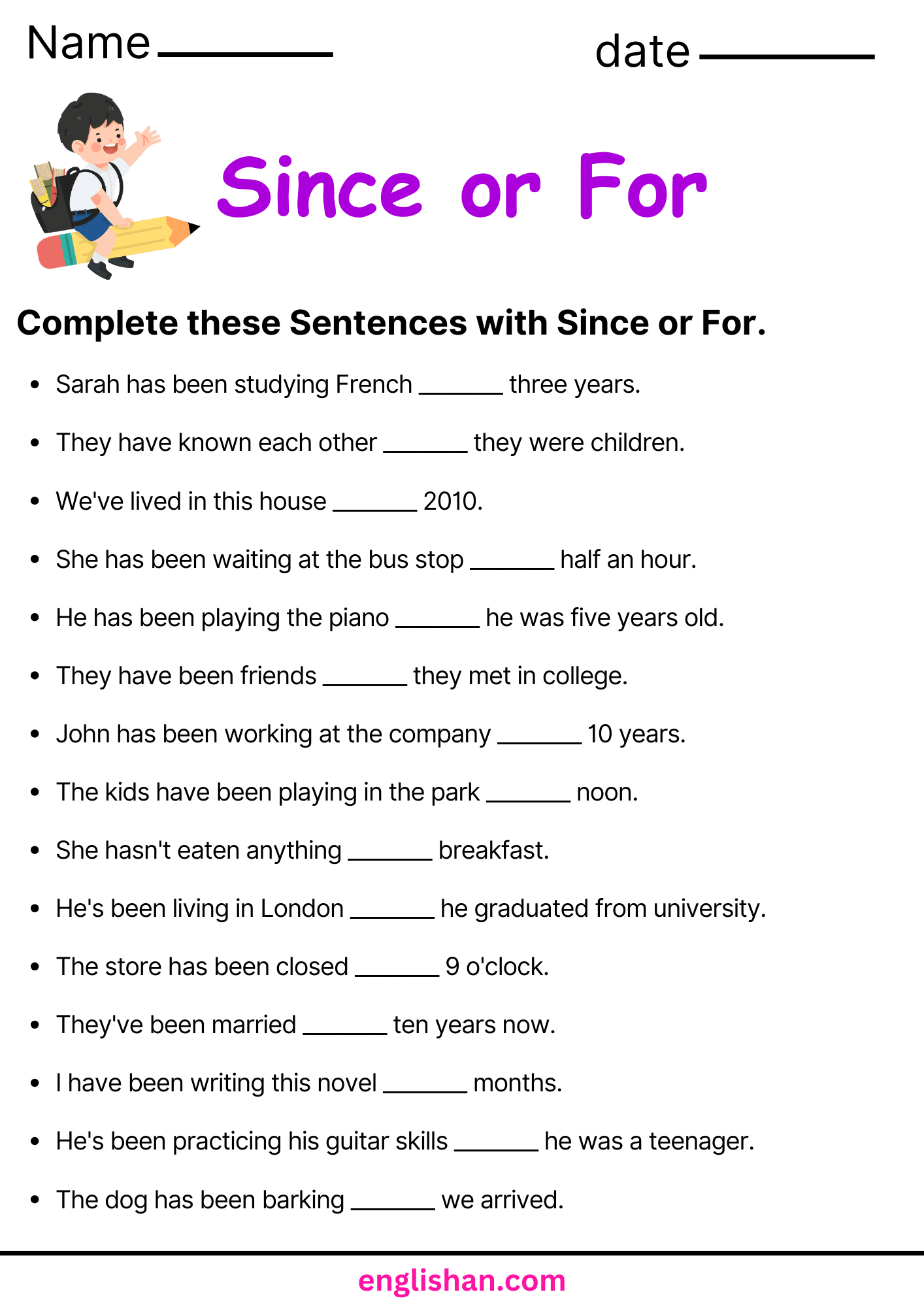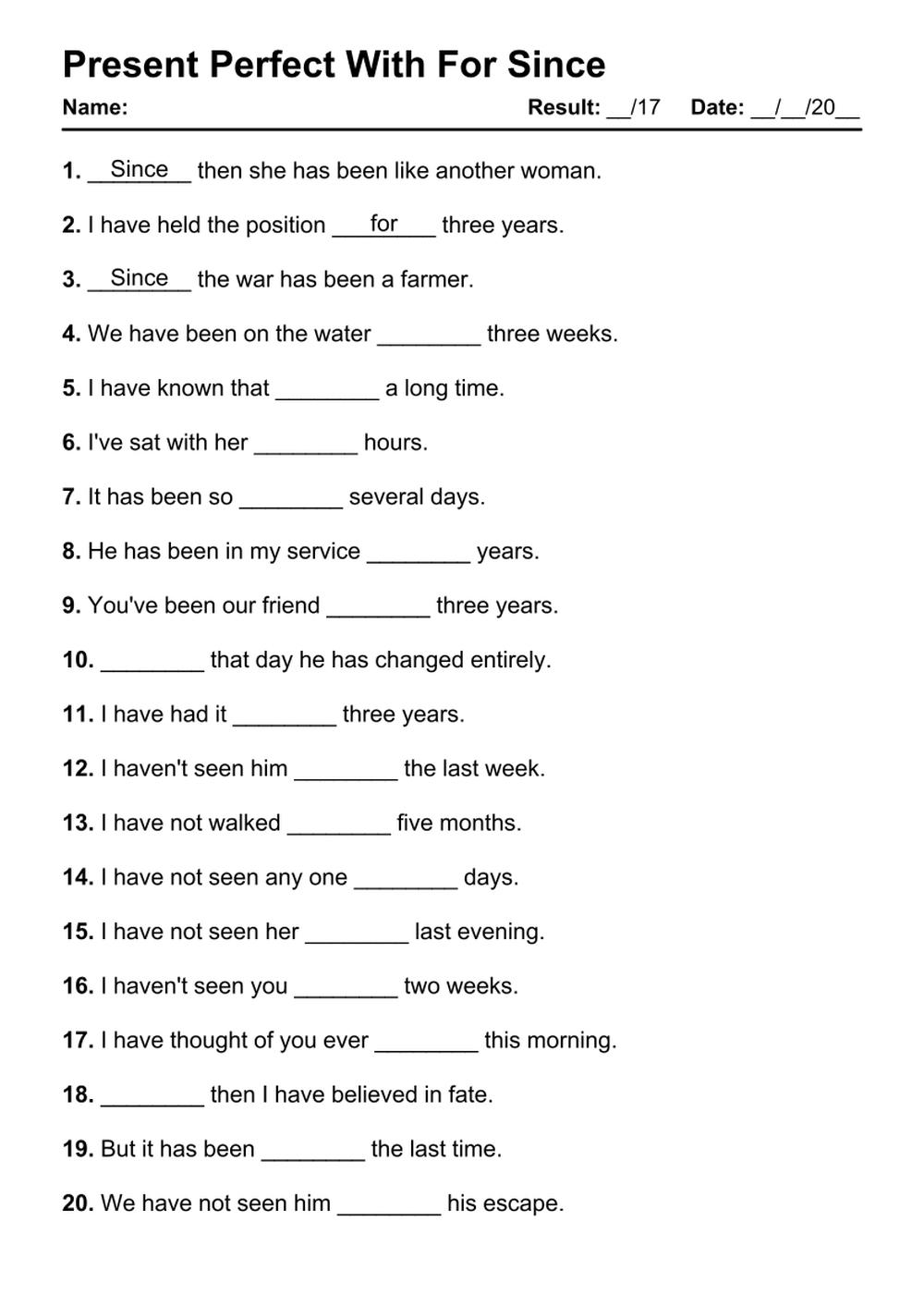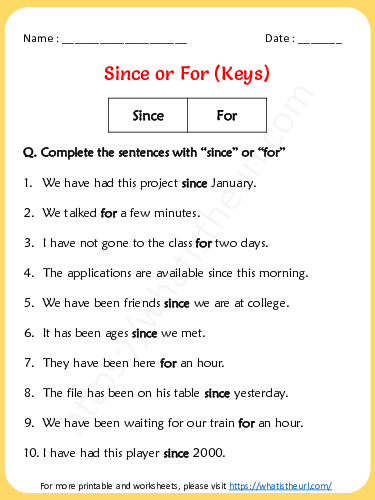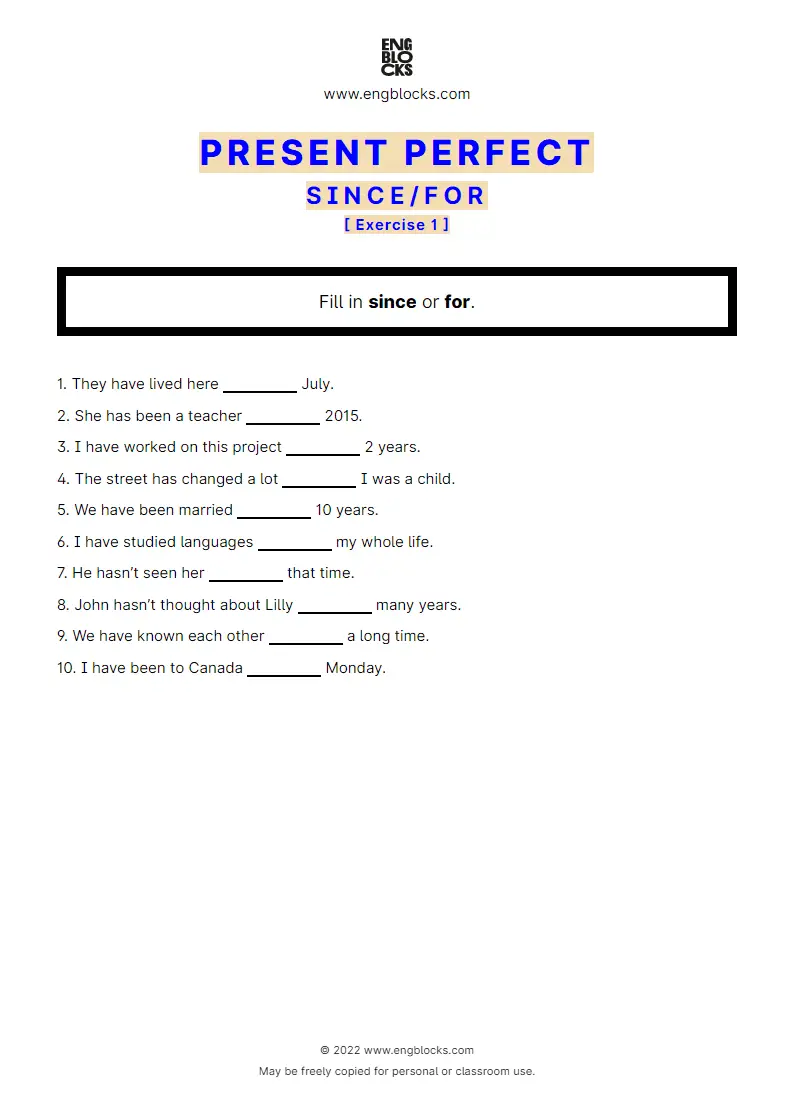
Mastering Time and Reason: The Indispensable Role of Grammar Worksheets: For/Since
English grammar, with its intricate rules and nuanced applications, can often feel like a formidable challenge for language learners. Among the myriad of grammatical concepts, the correct usage of "for" and "since" stands out as a particularly common stumbling block. These two seemingly simple words, while both relating to time, carry distinct meanings and are used in specific contexts that, if misunderstood, can lead to confusion and miscommunication. Fortunately, the path to mastery is well-lit by effective practice materials, particularly well-designed Grammar Worksheets: For/Since.
This article delves into the complexities of "for" and "since," elucidating their individual meanings, common pitfalls, and the specific tenses they pair with. More importantly, it will highlight why Grammar Worksheets: For/Since are not just supplementary tools but essential components in solidifying understanding, fostering retention, and ultimately empowering learners to use these temporal markers with confidence and precision.

The Distinctive Roles of "For" and "Since"

Before exploring the power of worksheets, it’s crucial to establish a clear understanding of what "for" and "since" signify.

Understanding "For": Duration, Purpose, and More

At its core, "for" is primarily used to indicate a duration or period of time. It answers the question "How long?" when referring to an action or state that has continued over a specific span.

- Duration: This is its most common use in the context of time.
- Examples:
- "I have lived in London for five years." (The duration of living is five years.)
- "She studied for three hours last night." (The duration of studying was three hours.)
- "They waited for a long time." (The duration of waiting was a long, unspecified period.)


- Key takeaway: When you can quantify the length of time, "for" is usually the correct choice. It can be used with various tenses, including simple past, simple present, and perfect tenses (present perfect, past perfect).

- Examples:

Beyond duration, "for" has other significant uses:
- Purpose or Reason: "For" can introduce the reason or purpose behind an action.
- Examples:
- "I bought flowers for my mother." (The purpose of buying flowers was for his mother.)
- "This tool is for cutting wood." (The purpose of the tool is cutting wood.)
- Examples:
- Recipient: It can indicate the recipient of something.
- Examples:
- "Here’s a gift for you."
- Examples:
- Exchange/Price:
- Examples:
- "I bought this book for ten dollars."
- Examples:
While "for" has multiple applications, its temporal use for duration is the one that most frequently causes confusion when juxtaposed with "since."
Understanding "Since": Starting Point and Reason
In contrast to "for," "since" is predominantly used to indicate a starting point in time. It answers the question "From when?" or "When did it start?" It points to a specific moment or event in the past from which something has continued up to the present or another point in time.
- Starting Point in Time: This is its most common temporal use.
- Examples:
- "I have lived in London since 2018." (The specific starting point of living was 2018.)
- "She hasn’t eaten anything since breakfast." (The specific starting point of not eating was breakfast.)
- "They have been married since they were 25." (The specific starting point of being married was when they were 25.)
- Key takeaway: "Since" always refers to a specific point in time (a year, a date, a time, an event). Crucially, when used temporally, "since" is almost exclusively paired with perfect tenses (present perfect, present perfect continuous, past perfect) because these tenses describe actions or states that began in the past and continue or have an effect up to another point in time.
- Examples:
Like "for," "since" also has another significant, non-temporal meaning:
- Reason or Cause (similar to "because"):
- Examples:
- "Since you’re busy, I’ll just leave the report." (Because you are busy, I will leave the report.)
- "She decided to stay home since it was raining heavily." (Because it was raining heavily, she decided to stay home.)
- Examples:
This dual nature of "since" can sometimes add another layer of complexity, but within the context of time, its primary function is to denote a specific origin point.
The Critical Distinction and Common Pitfalls
The most common error learners make is interchanging "for" and "since" when discussing duration versus starting point.
- Incorrect: "I have been here since two hours." (Incorrect, as "two hours" is a duration, not a starting point.)
- Correct: "I have been here for two hours."
- Incorrect: "She has worked here for 2015." (Incorrect, as "2015" is a starting point, not a duration.)
- Correct: "She has worked here since 2015."
Another pitfall involves tense usage. While "for" can be used with many tenses, "since" (in its temporal meaning) almost exclusively demands a perfect tense. You wouldn’t typically say "I live here since 2018" (simple present) but rather "I have lived here since 2018" (present perfect).
The Indispensable Role of Grammar Worksheets: For/Since
Given the subtle yet significant differences between "for" and "since," how can learners effectively internalize these rules and apply them correctly in real-time communication? The answer lies in structured, repetitive, and contextualized practice, which is precisely what Grammar Worksheets: For/Since provide.
1. Active Recall and Reinforcement:
Worksheets force learners to actively retrieve information from their memory and apply it. This active recall is far more effective for long-term retention than passive reading or listening. By repeatedly encountering sentences that require a choice between "for" and "since," learners reinforce the rules and patterns in their minds.
2. Identifying Specific Weaknesses:
A well-designed worksheet isn’t just about getting the right answer; it’s about understanding why an answer is correct or incorrect. If a learner consistently misuses "since" with durations, the worksheet acts as a diagnostic tool, highlighting that specific area for further focus and explanation.
3. Building Confidence:
Each correctly completed exercise builds confidence. As learners successfully navigate various scenarios, their belief in their ability to use "for" and "since" correctly grows, making them more likely to apply these words naturally in speaking and writing.
4. Contextualized Learning:
Effective Grammar Worksheets: For/Since don’t just present isolated sentences. They embed the target grammar points within meaningful contexts, such as short paragraphs, dialogues, or descriptions. This helps learners see how "for" and "since" function in natural language, rather than just as abstract rules.
5. Variety of Exercise Types:
Good worksheets offer a range of exercise formats to keep learners engaged and to target different cognitive skills:
- Fill-in-the-blanks: The most common, direct application.
- Sentence completion: Learners complete sentences using "for" or "since" with their own information.
- Error correction: Learners identify and correct mistakes in sentences that misuse "for" or "since." This hones their critical eye.
- Sentence transformation: Learners rewrite sentences, changing a duration to a starting point or vice-versa, forcing them to understand the underlying meaning.
- Question-and-answer: Learners answer questions using "for" or "since," prompting productive use.
- Open-ended writing prompts: Learners write short paragraphs or stories, integrating "for" and "since" naturally.
Designing and Utilizing Effective Grammar Worksheets: For/Since
For educators, creating impactful Grammar Worksheets: For/Since involves several key considerations:
- Clear Instructions: Ensure learners understand exactly what they need to do for each exercise.
- Gradual Difficulty: Start with simpler, more direct applications and progressively move to more complex sentences or contextualized passages.
- Relevant Vocabulary: Use vocabulary appropriate for the learners’ level to avoid cognitive overload.
- Authentic Scenarios: Create sentences that sound natural and reflect real-world communication.
- Inclusion of Perfect Tenses: Since "since" is heavily linked to perfect tenses, ensure plenty of exercises integrate these tenses to reinforce the connection.
- Answer Keys: Provide clear answer keys for self-assessment, allowing learners to check their work and understand their errors.
For learners, merely completing a worksheet isn’t enough. To maximize the benefit of Grammar Worksheets: For/Since:
- Don’t Rush: Take time to consider the meaning of the sentence and the specific time reference before choosing.
- Understand the "Why": After checking answers, don’t just note if it’s right or wrong. Understand why it’s right or wrong. If unsure, review the rules.
- Review Regularly: Revisit completed worksheets after a few days or weeks to test retention.
- Create Your Own Sentences: After completing a section, try to create five new sentences using "for" and five using "since" about your own life or experiences. This active creation solidifies understanding.
- Integrate into Speaking and Writing: The ultimate goal is to use "for" and "since" correctly in real communication. Consciously try to incorporate them into your conversations and written work.
Beyond the Worksheet: Real-World Application
While Grammar Worksheets: For/Since are invaluable, they are a stepping stone, not the final destination. True mastery comes from applying these concepts in authentic language use.
- Reading: Pay attention to how "for" and "since" are used in books, articles, and online content.
- Listening: Notice their usage in movies, podcasts, and conversations.
- Speaking: Consciously try to incorporate them when talking about durations or starting points in your life.
- Writing: Practice using them accurately in emails, essays, and personal journals.
By combining the structured practice offered by worksheets with exposure to and production of authentic language, learners can seamlessly transition from understanding the rules in theory to applying them naturally in practice.
Conclusion
The distinction between "for" and "since" might seem subtle, but it is fundamental to conveying precise temporal information in English. Misusing them can lead to awkward phrasing or, worse, misinterpretation. The journey from confusion to clarity is significantly aided by dedicated, well-structured practice.
Grammar Worksheets: For/Since serve as an indispensable tool in this journey, offering targeted practice that reinforces understanding, builds confidence, and addresses specific learning gaps. By actively engaging with these materials, understanding the underlying principles, and extending the learning into real-world communication, learners can confidently master these essential temporal markers. Embrace the power of practice, and watch your fluency in expressing time flourish.
